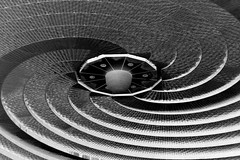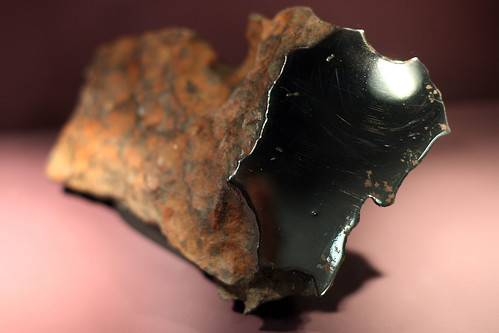

| Archive Blog Cast Forum RSS Books! Poll Results About Search Fan Art Podcast More Stuff Random |
|
Classic comic reruns every day
|
1 {photo of a girl drawing the solar system on a whiteboard}
1 Caption: Formation of the Solar System
|
First (1) | Previous (3232) | Next (3234) || Latest Rerun (2874) |
Latest New (5380) First 5 | Previous 5 | Next 5 | Latest 5 Annotations theme: First | Previous | Next | Latest || First 5 | Previous 5 | Next 5 | Latest 5 This strip's permanent URL: http://www.irregularwebcomic.net/3233.html
Annotations off: turn on
Annotations on: turn off
|
 A swirly, spirally thing, visually alluding to the formation of the solar system. |
Anyway, the cloud started to collapse and get smaller. Here's where the random motions become important. They weren't quite balanced, which meant that the cloud as a whole, if you averaged out all of the different motions within it, was rotating very slowly. Now if you take a rotating object and you squash it into a smaller space, the rotation speeds up.[1] Soon everything is rotating noticeably in the same direction.
In this rotating cloud there are some lumps, which begin to attract nearby matter by gravity. The lumps start to congeal, turning into what will become planets. In the very middle is the biggest lump of all, and it grows to a monstrous size. Eventually it gets so big that the pressure and temperature at the middle are high enough to cause hydrogen gas to fuse together in a nuclear reaction. This is the moment when the sun switches on.
Once this happens, the new solar radiation starts to gently blow away any leftover gas, out to interstellar space. The dust is swept up over time by the smaller lumps, which settle down to become planets. Around each planet a similar swirling rotation takes place and some of the material there ends up coalescing into moons that go around the planets.
There is some leftover material from each of these processes. Around the larger planets these may form delicate rings. Saturn has the best known rings, but Jupiter, Uranus, and Neptune all have smaller, fainter ring systems too.
 An iron meteorite, cut to show the metallic interior. |
The vaporising asteroids are commonly known as shooting stars, and technically as meteors. The vast majority are tiny. The bright streaks we can see in the sky are typically caused by objects the size of a pea or smaller, and many of them go largely unnoticed. Bigger objects entering Earth's atmosphere are much more rare. They produce larger and brighter streaks of light, until you end up with so-called fireballs that are visible to hundreds of people across large areas of countryside. And if the original asteroid is about half a metres or more across, only the outer layers will be vaporised and a chunk of material might survive the passage through the atmosphere to land on the Earth. At this point it becomes a meteorite. If you go to a science museum, they will almost certainly have some chunks of meteorites on display. Regard them well - these are rocks from space.
There's other stuff left over from the formation of the solar system too. Far out in the regions beyond the planets, the warming light of the sun is feeble, and the temperatures are very cold. Many of the substances that are gases in the inner solar system here form solid ices: water, carbon dioxide, methane, ammonia. These collect in lumps, mixed with grains of solid dust and rock. In the region beyond Neptune, and stretching to about twice as far away from the sun as that giant planet, lives a collection of such objects. The largest currently known object out here is called Eris. The second largest is Pluto. These objects are far from alone, rather being surrounded by a host of lesser bodies ranging in size up to Makemake, which is three-quarters the diameter of Pluto. And it's likely that still lurking out there awaiting discovery are even larger bodies.
This population of distant objects was discovered only in 1992, and today over a thousand are known thanks to our improved astronomical instruments. From the statistics, it's likely that there are approximately 100,000 individual objects with diameters over 100 kilometres, and millions of smaller ones. The region I'm talking about here comprises what are known as the Kuiper belt and the scattered disc objects that originated in the belt before being perturbed into more eccentric orbits by the gravitational influence of Neptune.
Much further out is an even more numerous collection of small objects left over from the formation of the solar system. Out here, in the vast space from about 100 astronomical units to about 100,000 astronomical units[3] from the sun. This is essentially from the outer edge of the planetary/Kuiper region, out to almost halfway to the nearest stars. This is a mind-bogglingly enormous volume of space. It's about 40 trillion times the volume of the sphere around the sun with a radius equal to Neptune's orbit.
 Lord's Cricket Ground, London. If this is the size of the Oort cloud, all the planets' orbits would fit inside a golf ball in the middle. Earth would be too small too see. |
This immense volume of space, or more particularly the vast number of small icy objects out here, is known as the Oort cloud. Despite the huge numbers, each object is small, and the total mass out here is only a small fraction of the mass of the sun and planets. For the most part, the objects of the Oort cloud, Kuiper belt, and scattered belt are dark and mysterious. You can't see any of them without a telescope. For most of our history we never had any clue whatsoever that they were even out there.
Actually, I lie.
For some of the objects in these distant regions are occasionally disturbed by the gravitational tugs of larger objects. These tugs can disrupt their slow, stately orbits and send them careening in towards the gravitational grip of the sun. As they fall inwards, they speed up. As they tumble in past Jupiter and towards the realm of the small, inner planets, the growing heat of the sun starts to melt the ices on their surfaces. As they fall further and further inwards, the ices vaporise and the gases and released dust stream away - not behind the object as it zooms inwards, but rather, because these materials are so light and diffuse, they get blown away by the solar wind. And so the object grows a long tail of material that points away from the sun.
This tail can be extremely long, covering an astronomical unit or more (hundreds of millions of kilometres). And it reflects sunlight. It can be visible from Earth, occasionally with the naked eye. The object itself is also surrounded by a denser cloud of vaporised gas, which reflects sunlight even more brightly. The resulting object forms a bright point in the night sky, with a dimmer tail streaming out behind it, across a large swathe of sky. The ancients noticed these objects appearing in their skies hundreds or thousands of years ago. In those times, superstition ruled and the appearance of such a rare and distinctive object in the sky was an omen. They called these apparitions comets.
 Comet McNaught in the dusk sky over Sydney, 2007. |
But in 1705 the astronomer and physicist Edmond Halley[4] realised that the comets of the years 1456, 1531, 1607, and 1682 could all be reconciled as being a single object, with a regular orbit, returning to the sun once every 75 and a bit years. Halley predicted the comet's return in 1758, but alas died in 1742 before seeing the comet again. It duly returned, and Halley posthumously gave his name to the most famous comet of all time.
Halley's comet and others like it that return to our skies with periods of a few years to tens of years have the outer edges of their orbits within the Kuiper belt region. The orbits can remain relatively stable for several passages through the inner solar system. They lose material on each passage, vaporised and blown off by the sun, but the amount of material lost is only a tiny fraction of the mass of the comet. A comet like Halley has a solid, frozen core of material a few kilometres across. Less than a thousandth of the material will be vaporised and lost on each orbit, so a comet can last a few thousand orbits before being exhausted. It's also possible for comets to break up into smaller fragments. An irregularly shaped comet, with gases and material being blown off by the sun, might crack up or be disrupted by the violence of the material being ejected. Comet Schwassmann-Wachmann 3 began breaking up in this way in 1995, and the process has continued on subsequent returns (there is an amazing video from the Hubble Space Telescope of the 2006 return at the linked Wikipedia page).
And even more dramatically, comets sometimes collide with other objects in the inner solar system. We were fortunate in 1994 to have advanced astronomical instruments to observe the spectacular collision of comet Shoemaker-Levy 9 with Jupiter. Apart from shooting stars, this was the first time we'd ever witnessed a collision of one solar system object with another.[5] This event gave us a first hand look at the processes that formed our solar system. Or rather, that are still forming our solar system. Because those processes never stopped, they just became somewhat less frequent as the density of objects around the planets dropped.
Our solar system is a dynamic, changeable place. The ancients saw comets as unwelcome disruptions in the fixed regularity of the heavens. Now, rather than fearing them, we welcome them as spectacular examples of just how varied and amazing our little neighbourhood of the universe is. Asteroids and comets are leftover bits of the processes that made the sun and planets five billion years ago. And the planets are still collecting them up and adding them to their inventories.
[1] This is because of a principle known as the conservation of angular momentum. The classic example given in all physics text books is an ice skater, spinning on the ice. As he draws his arms in, the spinning speeds up. This example is really just to give people a familiar case that is similar, it doesn't explain in any way why this happens, and any full explanation is tangential to today's topic so I'll leave it for another day.
[2] According to International Astronomical Union nomenclature, an asteroid is larger than 10 metres across, with anything smaller (and at least roughly large enough to be visible as a speck of dust) being called a meteoroid. This distinction is largely artificial however, and the objects form a continuum of sizes. I'll just call them all "asteroids" for simplicity.
[3] An astronomical unit (AU) is the distance from the sun to the Earth, roughly 150 million kilometres. It's probably the most grokkable unit with which to measure the distance within our solar system. The range 100 to 100,000 AU can also be written either as 15 billion to 15 trillion kilometres, or 0.0016 to 1.6 light years, if either of those actually makes it any easier for you to grasp. The distances here are so far beyond human experience that either way you express it, it really becomes just a jumble of numbers.
[4] Halley, by the way, was much more than this. A contemporary and friend of Isaac Newton, Halley lived a vastly more interesting and varied life than his better known cohort. There's a good reason he appears as a major protagonist in the Scientific Revolution theme comics of this very webcomic. If you have some spare reading time, you could do a lot worse than pick up a decent biography of Halley.
[5] In 1178, a group of medieval monks in Canterbury, England, recorded the following observation:
The upper horn [of the moon] split in two. From the midpoint of the division a flaming torch sprang up, spewing out, over a considerable distance, fire, hot coals and sparks. Meanwhile the body of the Moon which was below writhed, as it were in anxiety, and to put it in the words of those who reported it to me and saw it with their own eyes, the Moon throbbed like a wounded snake. Afterwards it resumed its proper state. This phenomenon was repeated a dozen times or more, the flame assuming various twisting shapes at random and then returning to normal. Then, after these transformations, the Moon from horn to horn, that is along its whole length, took on a blackish appearance.In 1976, geologist Jack B. Hartung interpreted this as an accurate eyewitness account of a meteoroid impacting the surface of the moon. Such an impact, he calculated, would indeed release a glowing flare visible from Earth. What's more, the position of the flare as described by the monks matched fairly well to the position of the crater Giordano Bruno on the moon's surface - a crater known by its geological features to be very young, and plausibly only 900 years old. In 2001, however, astronomer Paul Withers calculated that an impact large enough to form Giordano Bruno (which is 22 kilometres across), would have ejected an immense amount of material into near-Earth space, causing by far the most spectacular meteor showers ever witnessed for a week or more. Such an occurrence would scarcely have gone unnoticed by medieval observers, yet is not recorded in any historical chronicles from any culture in the world. On balance, it seems most likely that the monks didn't actually observe an impact on the moon.
Dang.
|
LEGO® is a registered trademark of the LEGO Group of companies,
which does not sponsor, authorise, or endorse this site. This material is presented in accordance with the LEGO® Fair Play Guidelines. |